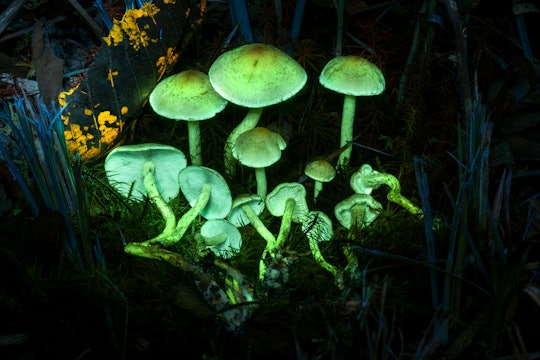
Alan Rockefeller via Mushroom Observer

Produced in partnership with NPR Scicommers
Fungi create genes to "win over" their plant friends and neighbors
The vast majority of plants depend on fungi for life, and fungi are always learning how to best befriend plants
The soil beneath our feet is like a noisy bar where getting the attention of your crush can be an impossible mission. Plants and fungi face similar problems hearing each other through all the "noise" in the soil. Good communication is not just important for their mutual survival, it can also have a profound impact on the food crops we rely on to eat.
About 80 percent of plants depend on a symbiotic relationship with fungi to stay alive. For example, fungi get sugars from plants, and fungi supply plants with soil minerals that are far away from their location.
Monocultures, where large fields have only one kind of plant like wheat, soybean, and corn can deplete soil nutrients. Using fungi could be a way for farmers to help their crops get more, but matching the fungi to a specific crop can be challenging: we need to know how they communicate using specific genes.
Researchers have found that fungi can gain genes for plant-attracting characteristics in multiple ways, including making them from scratch or borrow from other fungi.
After fungi exposure to the root, if plants express a specific gene at their root during symbiosis, it can suggest that might be important fungi communication, explains Yen-Wen (Denny) Wang, a graduate student at the University of Wisconsin-Madison and author of a recent study on fungi genes and plant relationships published in the Genome Biology and Evolution journal.
Mutualistic fungi, the type that partners with plants are constantly evolving and understanding how their genes for communication change over time can be quite tricky. Wang's study pulled sequences from databases and compared them to figure out how fungi "learn" to talk to plants by making new genes from scratch or borrowing from other fungi.
During the study, Wang uncovered a gene in the Amanita fungi he was studying that was duplicated. This gene was responsible for degrading the cellulose from plants. They hypothesize this duplication might be used for substrate degradation. Other fungi that are harmful to plants like Pyrenophora tritici-repentis have duplicated genes that are virulent and harm wheat plants.
.jpg)
Ectomycorrhizal symbiosis, showing root tips with fungal mycelium from the genus Amanita
Ellen Larsson via Wikimedia
Another strategy Wang uncovered while tracking fungi genes was gene duplication, which is the equivalent to having a similar pick-up line twice in your repertoire. With this strategy, fungi can modify the duplicated gene leading to new functions and impressing plants in the way leading to perhaps forge a better relationship.
With three options to choose from, gene swap, gene duplication, and making new genes, how do fungi decide which will be their first move? Let’s crash a fungus and plant’s date.
Plants aren't very romantic, they usually have their guard up for indications that their prospective fungi dates have ill-intentions and could make them sick.
In just one gram of soil, there are thousands of pathogenic and symbiotic organisms, explains Dr. Peter Pellitier, a postdoctoral fellow at Stanford Biology & UC Santa Cruz Environmental Studies.
“You're probably picking up thousands of different fungal species,” he says. “And so, the plant is trying to sort through, like who's good, who's bad.” Parsing through the bad and good actors in the soil is crucial for a plant’s survival.
“If the plants cannot recognize those pathogens, then the plants could go extinct,” says Wang. These pathogens can take advantage of plants to the extent they leave plants without nutrients and eventually killing them. If plants did not know how to sort through good and bad actors, it could lead to an epidemic and even the end of the species in extreme cases.
During their first “date” or encounter, some plants will send chemicals to their roots to drive off harmful organisms, like some fungi. But fungi have evolved counter-measures to plant defenses. Some fungi families have acquired a gene that codes for the enzyme deaminase, which transforms the defense chemicals into something less harmful to fungi and turns off the defense response. According to Wang's study, friendly fungi could have gotten this gene strategy from harmful fungi, but contrary to them, fungi want a healthy relationship with plants.
“It's pretty interesting that this gene is actually from other fungi,” says Wang. These fungi got the deaminase gene through horizontal gene transfer, which is when fungi exchange genes with one another, from a fungus that is not symbiotic, and repurposed it for friendly relationships. This dance of genes is what makes their relationship blossom, for their mutual benefit.
Knowing where these genes come from and how fungi employ them answer a fundamental evolutionary question in the field of biology and set the foundation for understanding fungi communication. In addition to these genes, fungi have "junk DNA" that most people thought wasn't useful. However, Wang thinks otherwise " I hypothesize that these genes are pretty important to the fungi, as well...they introduced very different kind of tools for the fungi." Determining the evolutionary fundaments of fungi and how they communicate can be leveraged by other fields like agriculture to improve crop cultivation.
